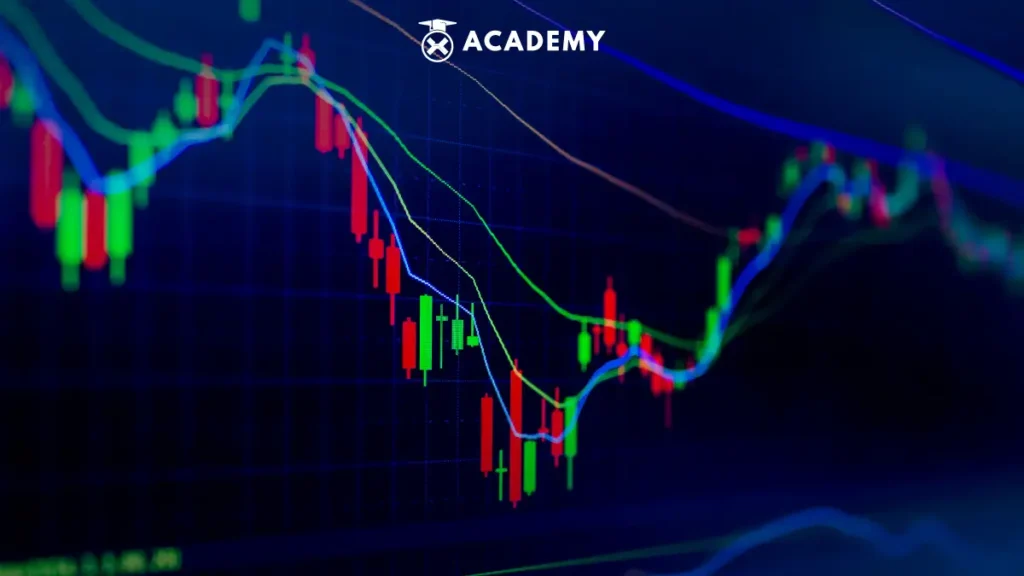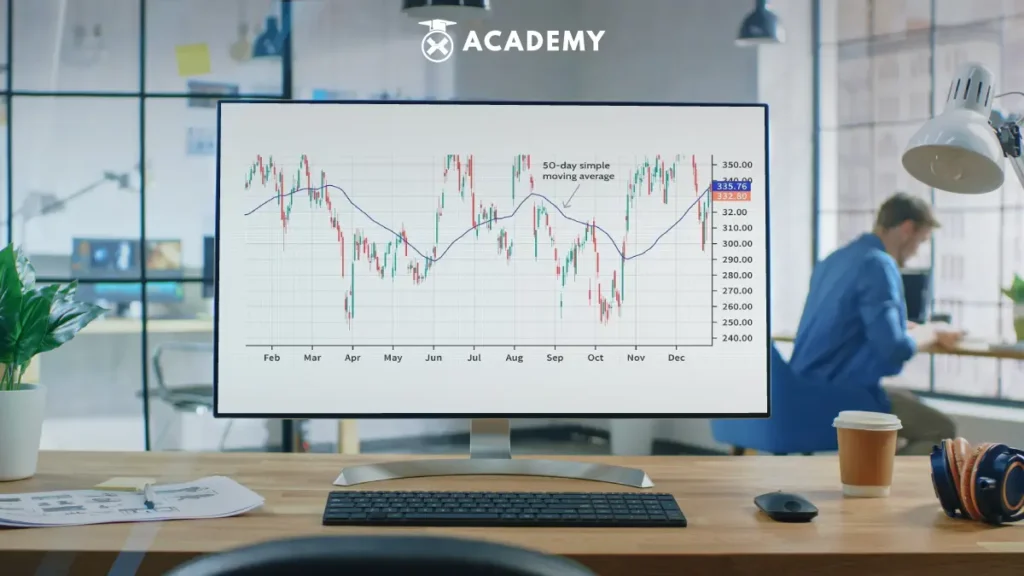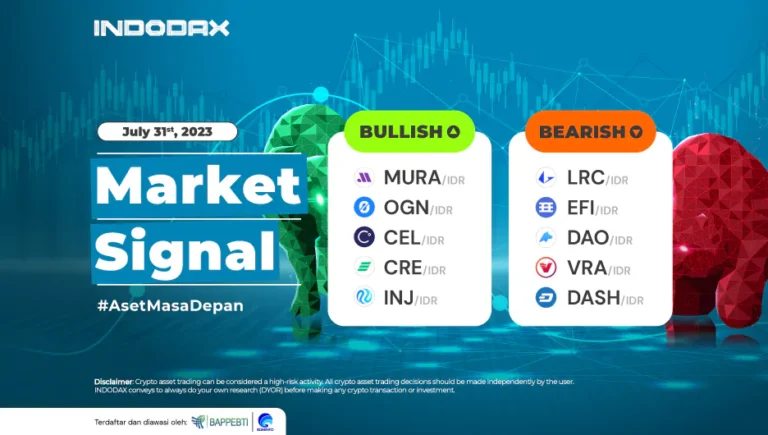In the investment world, including stocks and crypto assets, several concepts/calculations are important for traders to understand, including the Moving Average (MA).
Moving averages are used in technical analysis to help predict market trends.
So, to find out more about moving averages, types, and how to calculate them, see the following review.
Definition of Moving Averages
Moving Average is an indicator/statistical method used to smooth time/time series data by calculating the Average of the last number of data points.
This method is useful for identifying hidden trends or patterns in data and eliminating random fluctuations that can complicate analysis.
Simply put, a moving average takes the least amount of data in a time series and calculates the Average.
MA can be used for various purposes, including identifying trends, predicting future behavior, or eliminating random fluctuations in data.
Historically, the MA method is believed to have been used since the late 18th or early 19th century.
One of the earliest examples of the use of MA was in the field of astronomy, to be precise, in 1811, by Carl Friedrich Gauss, a mathematician, and astronomer.
Later, throughout the 20th century, MA became more popular and is used in various disciplines, including economics, finance, and social sciences.
Examples of Using Moving Averages in Technical Analysis
Moving Average is one of the indicators commonly used in technical analysis to read stock price charts or other financial instruments.
MAs smooth out daily price fluctuations and help identify underlying price trends.
Some examples of using MA in technical analysis are identifying trend directions, confirming trend changes, dynamic support and resistance, determining entry and exit points, and identifying overbought or oversold conditions.
Meanwhile, one of the uses of MA in technical analysis is to use a Moving Average crossover.
Moving Average crossover occurs when two Moving Average lines with different periods cross.
Examples of its use are:
- The golden cross.
- The death cross.
- The cross is in the middle of the chart.
- Confirming other signals.
- Setting different periods.
Purpose and Function of the Moving Average

The main purpose of the Moving Average (MA) is to help identify trends or patterns in data.
Using MAs, price fluctuations or daily data can be smoothed out to make the underlying trend easier to see.
Using moving averages effectively can help traders and analysts gain better insight into market trends, identify support and resistance levels, and make more informed trading decisions.
Following are some of the objectives and other functions of the moving Average (MA), namely:
1. Identify market trends
The purpose and another function of the Moving Average (MA) is to help identify market trends.
In technical analysis, market trends are price movements that show a dominant direction over a certain period.
MAs are used to identify market trends by eliminating noise, providing views of different timeframes, identifying trend directions, signaling trend reversals, and confirming trends with other indicators.
Through moving averages in identifying market trends, traders or analysts can make better trading decisions and benefit from continuous price movements.
2. Smooth data fluctuations
Another purpose and function of the Moving Average (MA) is to smooth out data fluctuations.
When using MAs, volatile data is smoothed out to make the underlying trend more visible.
MA is used to smooth data fluctuations by eliminating noise or noise, helping to identify long-term trends, providing different timeframe perspectives, identifying trend changes, and making it easier to identify important patterns and levels.
3. Provide trading signals
The purpose and another function of the Moving Average (MA) are to provide trading signals. MAs can be used to identify potential moments to enter or exit the market.
Several reasons MA is used to provide trading signals are identifying trend changes, confirming other trading signals, identifying dynamic support and resistance levels, using multiple moving averages, and identifying trend momentum and strength.
Types of Moving Averages
Understanding the types of Moving Averages (MA) has several important advantages in technical analysis.
Understanding the different types of moving averages helps traders and technical analysts recognize market trends, identify support and resistance levels, and generate useful trading signals.
It is an important tool in technical analysis that can help increase understanding and better decision-making in trading.
The following are the types of Moving Averages that you need to know, namely:
1. Simple Moving Averages (SMA)
The Simple Moving Average (SMA) is one of technical analysis’s most basic and most commonly used moving averages.
SMA gives the same weight to each period, thus providing a smoother movement.
SMA is often used to view the overall price trend, identify support and resistance levels, and generate trading signals based on price crossovers.
2. Exponential Moving Average (EMA)
Exponential Moving Average (EMA) is a type of Moving Average that gives a different weight in each period, with the weight set based on the exponential factor.
EMA gives more weight to recent price data, making it more responsive to recent price changes.
The EMA calculation uses two main components: the current closing price and the previous EMA.
3. Weighted Moving Average (WMA)
Weighted Moving Average (WMA) is a type of Moving Average that gives different weights to each period, and the weights are determined manually.
WMA pays different attention to recent prices and older prices based on assigned weights.
How to Calculate Moving Average
Understanding how to calculate the Moving Average (MA) has several important advantages in technical analysis.
By understanding how to calculate MA, you will have a deeper understanding of this technical analysis tool and be able to use it more effectively in trading and investment decision-making.
It is an important step to understand technical analysis as a whole comprehensively.
Following are some formulations of the types of MA, namely:
1. Formula for the Simple Moving Average
The formula for the Simple Moving Average (SMA) is:
SMA = (Sum of closing prices for n periods) / n
In this formula, “Sum of closing prices for n periods” refers to the sum of the closing prices for the specified n periods.
Then, the sum is divided by the number of periods n. For example, if we wanted to calculate the 20-day SMA, we would add up the last 20 days closing prices and then divide the result by 20.
This process is repeated every day to generate a new SMA value. The following is an example of calculating SMA:
Day 1: Closing price = 50
Day 2: Closing price = 55
Day 3: Closing price = 60
…
Day 20: Closing price = 70
20-day SMA = (50 + 55 + 60 + … + 70) / 20
In this example, we add the closing prices of the last 20 days and divide the result by 20 to get the 20-day SMA.
2. Formula for Exponential Moving Average
The formula for the Exponential Moving Average (EMA) is as follows:
EMA = (Current Closing Price – Previous EMA) x Smoothing Factor + Previous EMA
In this formula, “Current Closing Price” refers to the most recent closing price, “Previous EMA” refers to the previous EMA value, and “Smoothing Factor” is the smoothing factor used to set the weight at the latest price.
The EMA calculation process starts with the initial EMA value, which can be taken as the selected period’s Simple Moving Average (SMA).
Then, the above formula is repeated for each subsequent period. The smoothing factor in the EMA calculation can be calculated using the following formula:
Smoothing Factor = 2 / (N + 1)
In this formula, N is the period used for EMA calculations.
EMA calculation example:
Day 1: EMA = Closing Price 1 (SMA)
Day 2: EMA = (Closing Price 2 – EMA of previous day) x Smoothing Factor + EMA of previous day
Day 3: EMA = (Closing Price 3 – EMA of previous day) x Smoothing Factor + EMA of previous day
3. Formula for Weighted Moving Average
The formula for the Weighted Moving Average (WMA) is as follows:
WMA = (P1 * W1 + P2 * W2 + … + Pn * Wn) / (W1 + W2 + … + Wn)
In this formula, “P1, P2, …, Pn” refers to the closing prices of each selected period, and “W1, W2, …, Wn” refers to the weight assigned to each closing price.
The weight in WMA is determined manually and may vary. For example, if you use WMA with a period of 5 and the assigned weights are 0.5, 0.3, 0.1, 0.05, and 0.05, P1 will be multiplied by the weight of 0.5, P2 multiplied by the weight of 0.3, and so on.
Then, the results of this multiplication are added up and divided by the total number of weights.
The following is an example of calculating WMA:
Day 1: Closing price = 50, Weight = 0.5
Day 2: Closing price = 55, Weight = 0.3
Day 3: Closing price = 60, Weight = 0.1
Day 4: Closing price = 65, Weight = 0.05
Day 5: Closing price = 70, Weight = 0.05
WMA 5 days = (50 * 0.5 + 55 * 0.3 + 60 * 0.1 + 65 * 0.05 + 70 * 0.05) / (0.5 + 0.3 + 0.1 + 0.05 + 0.05)
Advantages of Using Moving Averages

Understanding the advantages of using the Moving Average (MA) is important in technical analysis and trading decision-making.
Understanding the advantages of using MA helps traders and analysts recognize trends, confirm trading signals, identify support and resistance levels, determine entry and exit points, manage risk and manage trading positions.
It becomes an important tool in technical analysis that can improve understanding and better decision-making in trading.
Following are some of the advantages of using MA, namely:
1. Reducing noise in the data
One of the main advantages of using a Moving Average (MA) is its ability to reduce noise in the data.
Noise is random fluctuations or irrelevant signals that can appear in price data or technical indicators.
This noise can make identifying true trends or valid trading signals difficult.
By using MA, especially smoother types of MA such as Simple Moving Average (SMA) or Exponential Moving Average (EMA), noise in the data can be reduced or smoothed out.
MA calculates the average closing price over some time and thus smooths out daily fluctuations that may be insignificant in the long term.
By reducing noise, MAs help clarify underlying market trends. This allows traders and analysts to see whether the trend is up, down, or flat.
In trading, recognizing clear trends is the key to making better decisions and following the dominant direction in the market.
2. Clarify the direction of price or value movement
Another advantage of using a Moving Average (MA) is its ability to clarify the direction of price or value movement.
By clarifying the direction of price or value movement, MAs help traders and analysts identify long-term trends, identify trend changes, gauge trend strength, and make better trading decisions.
MAs are an important tool in the technical analysis used to see a clearer and more consistent picture of overall price or value movements.
3. Helps in making better decisions
The next advantage of using a Moving Average (MA) is that it helps make better trading or investing decisions.
By using MA in decision-making, traders can rely on more objective and systematic analysis.
MAs provide a framework to help traders better identify trends, confirm signals, determine key levels, and manage risk.
By taking advantage of these advantages, traders can make better decisions and produce more consistent trading results.
Constraints of the Moving Average
Understanding the limitations of the Moving Average (MA) is very important in technical analysis.
Understanding the limitations of MAs helps traders and analysts to avoid misinterpretation and set expectations more realistically.
With a proper understanding of these limitations, traders can use MAs effectively as part of their trading strategy and integrate other analysis tools to optimize trading decisions.
Here are some limitations of the Moving Average, namely:
1. Moving averages can lag in volatile market conditions
One of the limitations of moving averages (MA) is that they can lag in highly volatile market conditions.
High volatility can lead to rapid and sharp price movements, leading MAs to produce delayed or inaccurate signals.
This is due to the nature of MA, which relies on past data and uses the averaging method to calculate the average value.
2. Sometimes moving averages can generate wrong signals
Another limitation of moving averages (MA) is that they can generate false or false signals.
Traders can use several strategies to deal with false or false signals from MA.
This includes confirming MA signals with technical indicators or other analytical tools, using multiple time frame analyses to validate the signal, or combining MAs with different periods to get a stronger confirmation.
In addition, good risk management and stopping losses can help protect positions from false signals.
Conclusion
Moving Average is an indicator/statistical method used to smooth time/time series data by calculating the Average of the last number of data points.
MA helps identify hidden trends or data patterns and eliminates random fluctuations that complicate analysis.
In short, MA will take the least amount of data in the time series and calculate the Average.
Fundamentally, MA can be used for various purposes, including identifying trends, predicting future behavior, or eliminating random fluctuations in data.
Because of this, traders are highly recommended to use Moving Averages in technical analysis but still pay attention to several things, namely set goals and trading periods, and use MAs with different periods.
Furthermore, traders must confirm with indicators or other analytical tools, pay attention to changes in the direction and slope of the MAs, use the MAs together with price analysis and candlestick patterns, manage risk using stop losses, and carry out tests and monitor results.
Now, you understand a moving average and how to calculate it.
Furthermore, you can also read other interesting articles, such as crypto technical analysis and regression analysis, at INDODAX Academy.
Come on, start investing in crypto assets right now!








